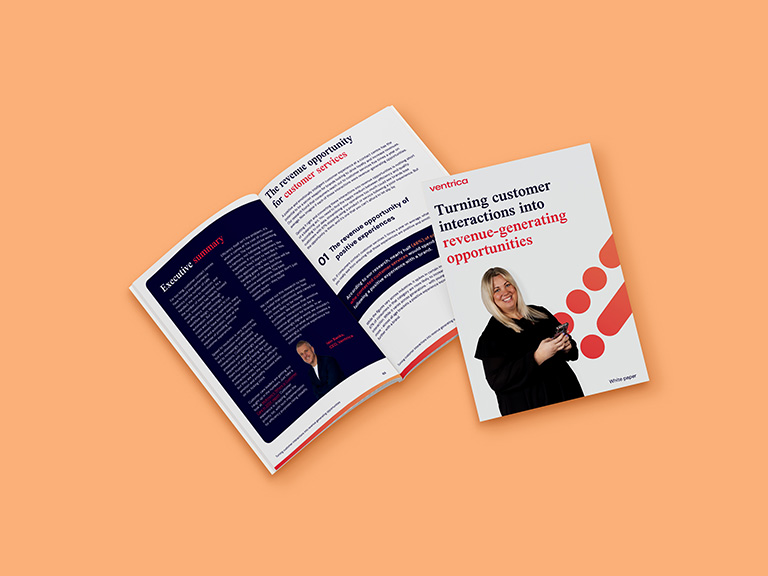Building a customer experience strategy that actually works
Most businesses mistake scattered CX tactics for a true strategy - and pay the price in loyalty and revenue. But why do why most CX plans collapse? What separates high-performing customer experience strategies from the rest?
- Insights, blogs & articles
Customer experience (CX) has become a make-or-break priority for businesses; research shows that 54% of consumers would stop using a brand after just one negative experience. Conversely 86% of buyers are willing to pay more for a great experience, underscoring how good CX impacts loyalty and revenue. Yet there’s a huge disconnect – while 80% of companies think they deliver superior CX, only 8% of customers agree. Clearly, most businesses are falling far short, despite their best intentions.
The culprit, in most cases, is a flawed approach to CX strategy. Too often, what companies call “strategy” is really just a scattershot of tactics with no unifying vision or sustained execution. In this piece, we explore how to build a true customer experience management strategy – one that is tactical but also strategic, resilient against common failure points and set up to deliver real, lasting results.
Stop calling it “strategy” if it’s just tactics
It’s easy to label any CX improvement a “strategy”. Whether it’s launching a new customer survey program, revamping a website or rolling out frontline staff training are all good initiatives, but on their own these are tactics – not cohesive strategy. A true strategy provides an overarching game plan and a long-term direction, whereas tactics are the specific actions taken along the way. Most businesses confuse the two, and as a result their so called “CX strategy” is just a grab-bag of disconnected projects.
Organisations get preoccupied with tactical KPIs (like NPS scores, CSAT surveys or quick fixes to customer touchpoints) and lose sight of the bigger picture. If all you have is a list of CX initiatives with no unifying purpose or integration, then you don’t have a real strategy – you have a set of tactics.
And you may ask “what’s the risk in mislabelling tactics as strategy?” For one it builds complacency. Leadership may believe that CX is “handled” because several projects are in motion, even though there’s no clear roadmap tying those efforts to meaningful business outcomes. It can also lead to disillusionment; teams invest in tools or gimmicks (say, a fancy new chatbot or a one-off customer event) expecting transformational results that never materialise. When those isolated tactics don’t move the needle on customer loyalty or revenue, everyone wonders why the “strategy” failed – when in fact there was no true strategy to begin with.
The key point – don’t call it strategy unless it provides clear direction and coherence. A genuine customer experience strategy isn’t a laundry list of ideas or a short-term campaign – it’s a deliberate plan that links every tactic to a broader vision and goal.
What a real customer experience strategy is
So if a random collection of tactics doesn’t count as a CX strategy, what does? A real customer experience strategy is an actionable plan to deliver a positive, meaningful experience across all touchpoints between your customers and your brand. In simple terms, it’s a roadmap for how your company will consistently meet or exceed customer expectations at every step of the journey. A solid CX strategy has several defining characteristics:
Clear vision and alignment
The strategy should be rooted in your organisation’s mission, brand promise and business objectives. The strategy defines why exceptional customer experience matters for your company (i.e. to drive loyalty, differentiate from competitors, support a premium pricing model, etc) and ensures every CX initiative aligns with those high-level goals. In fact, corporate strategy and customer experience strategy should be mirror images – if your CX efforts don’t support your overall business strategy, they’ll be viewed as side projects rather than mission-critical work.
Customer-centric focus
A real CX strategy starts with deep customer insight. This means grounding your plan in competitive research, customer feedback, journey mapping and voice-of-customer data. You need to understand your customer’s needs, preferences, pain points and moments of truth. For example, who are your different customer segments and what does each value most? What does a “great experience” look like to them? A strategy uses these insights to set experience standards and priorities. By contrast – a tactics-only approach might implement changes based on hunches or generic best practices, rather than specific customer data.
Cross-functional involvement
Customer experience is not just the domain of customer service or marketing. If touches product development, sales, operations, IT, HR – virtually every department. Thus, a genuine CX strategy involves all parts of the organisation in its design and execution. It breaks silos by establishing shared CX goals and encouraging collaboration across teams. Everyone from the CEO to frontline teams should understand the CX vision and their role in delivering it.
Long-term and adaptive
Strategy is by nature long-term and forward-thinking. A CX strategy isn’t about one quarterly boost in customer satisfaction – it’s about sustaining excellent experiences year after year, adapting as customer expectations evolve. This means building mechanisms to continuously listen, learn and improve. It also means being willing to invest in foundational capabilities like data systems, training or process redesign – that may not pay off overnight, but are crucial for lasting CX success.
In summary, a real customer experience strategy provides a unifying vision of what great CX looks like for your organisation and a concrete plan for how to achieve it across every customer interaction. It aligns with business goals, is driven by customer insight, engages the whole company and is built for the long haul. It’s the “north star” that guides all customer-focused initiatives, ensuring they add up to something meaningful.

Why most CX management strategies collapse
Many CX strategies collapse not because the ambition is wrong, but because the foundations are weak. Too often, leadership declares a commitment to “customer centricity” without providing the sponsorship or resources to make it real. Without ownership in the boardroom, CX quickly becomes a side project, easy to cut when pressure mounts.
Even where intent is strong, programmes stumble because they fail to show commercial value. Improving satisfaction is a worthy goal, but if it isn’t tied to retention, churn, or revenue growth, the strategy is soon dismissed as soft. In tough times, initiatives that can’t prove ROI rarely survive.
Internal silos cause further damage. CX spans marketing, sales, service, operations, and IT, yet many organisations run isolated projects that produce fragmented experiences. What should be a unifying vision becomes a patchwork of disconnected efforts. And finally, there is the failure to act. Companies gather feedback, run surveys, and track scores, but too often insights are never translated into change. Employees lose faith, customers see no difference, and the strategy withers into a reporting exercise.
In short, CX strategies collapse when they lack leadership, fail to prove value, remain siloed, or never turn listening into action. Avoiding those pitfalls is the first step to building a strategy that endures.
The five pillars of CXM – how to biuld a customer experience management strategy that lasts
Designing a customer experience management strategy that stands the test of time requires focusing on a few core pillars. These are fundamental areas that, when built up, support a sustainable and effective CX program. Based on industry best practices and lessons for failures, here are the five pillars of CXM to anchor your strategy:
Vision and leadership commitment
Every lasting CX strategy starts at the top. Leaders must define what great customer experience means for the business, and why it matters – and then champion that vision consistently. Governance is essential; clear ownership of CX outcomes, cross-department co-ordination and accountability structures ensure the strategy is embedded in company DNA rather than treated as a side initiative. Without executive commitment and alignment to business goals, a strategy will quickly lose momentum.
Customer understanding and insight
Strategies collapse when they’re not rooted in genuine customer understanding. Winning organisations go beyond surveys – they analyse behaviour, map journeys and integrate data across touchpoints to build a single view of the customer. This insight must then be acted upon – redesigning processes where pain points appear and personalising interactions where value can be added. Customer understanding is a living discipline – listening and adapting must never stop.
Customer-centric culture and employee engagement
Even the sharpest strategy document fails if people don’t deliver it. A customer-centric culture, backed by training, empowerment and recognition, ensures employees have the mindset and tools to act in the customer’s interest. Frontline staff must feel ownership of the experience, with the authority to resolve issues on the spot. Breaking down silos and rewarding collaboration turns customer focus into a shared responsibility, not a slogan.
Seamless processes and channel consistency
Customers expect consistency with every interaction. That requires integrated systems, streamlined processes and one single coherent voice across every channel. Whether a customer starts online, moves to mobile or picks up the phone, the experience should feel effortless and joined-up. Behind the scenes, technology and workflow design must eliminate friction and enable scale. Well-orchestrated processes not only improve convenience, but ensure the strategy holds up under pressure.
Measurement and continuous improvement
Finally – what gets measured, gets managed. A robust CXM strategy defines metrics that matter – NPS, CSAT, effort scores, retention, lifetime value – and uses them to drive change, not just reporting. Feedback loops should be fast and visible, with insights acted upon and results communicated back to customers. Continuous improvement keeps the strategy relevant as expectations shift. In practice, this means reviewing data regularly, learning from failures and adjusting quickly. The businesses that thrive are those that treat CX as a cycle of measurement, learning and adaptation – not a one-off initiative.
These five pillars reinforce each other to build a robust customer experience management strategy. If one is weak, the whole structure is compromised. You might have great insights and processes, but without the right culture, execution will fail. Or, you have leadership buy-in and engaged staff, but if you aren’t listening to customers or iterating, your strategy will become obsolete.
By strengthening each pillar, you create a strategy that can withstand pressure and stay on course for the long run. However – strategy isn’t theoretical; it’s executed through concrete actions. So how do you build out and implement your CXM strategy so that it holds up against real-world pressure and delivers results?

The “how” – building a CXM strategy that holds up under pressure
A customer experience strategy only proves its worth when it moves from presentation slides to the messy reality of day-to-day operations. This is where many organisations stumble. Ambition is rarely the problem; it’s execution under pressure that exposes whether a strategy is robust or fragile. To hold up in practice, CXM must be pragmatic, incremental, and continuously managed.
Start small, then scale
The first discipline is phasing. Too many strategies launch with sweeping promises to transform the entire customer journey, only to collapse under the weight of unrealistic scope. A stronger approach is to start small and scale deliberately: identify the journeys causing the most pain, fix those first, and demonstrate measurable impact. Each improvement builds confidence, proves ROI, and creates a foundation for the next phase. A strategy stress-tested in increments will always be stronger than one introduced as a “big bang” without groundwork.
Make CX everyone’s job
Execution also demands true cross-functional ownership. Customer experience touches every corner of the business, so relying on one department to “run CX” guarantees fragmentation. The organisations that deliver under pressure establish a central CX team with representation from across marketing, service, product, IT and operations. This group coordinates initiatives, shares insights, and acts quickly when challenges emerge. Crucially, they are empowered with authority and resources: frontline employees can resolve issues on the spot, and leadership can allocate budget without bureaucratic delay. Without this alignment, the strategy stalls the moment pressure mounts.
Use technology as an enabler
Technology underpins modern CX, but it is not the strategy itself. The temptation to invest in the latest platforms is strong, yet tools should only be adopted where they directly reduce friction or add value. A CRM that unifies data across touchpoints, analytics to identify pain points, or automation to remove repetitive tasks can transform the experience; a tool deployed for its novelty will only add complexity. The right infrastructure ensures your CX strategy can bear the load when volumes surge or channels multiply, without the experience breaking down.
Test before you scale
No matter how well designed, every process will eventually meet reality-and that is why testing matters. Pilot initiatives with small groups of customers, simulate high-pressure scenarios with staff, and prepare contingency plans for failures. Customers judge you most in moments of stress: a delayed order, a system outage, an unexpected error. A strategy that anticipates these scenarios and trains employees to handle them calmly will emerge stronger, while one untested will fracture.
Embed continuous adaptation
Finally, resilience comes from a culture of measurement and adaptation. Real-time dashboards and regular reviews of satisfaction, effort, or retention metrics are only valuable if they drive action. The organisations that thrive are those that listen, learn, and adjust at pace. They close the loop with customers, respond visibly to feedback, and treat each misstep as an opportunity to refine. This creates a living system: one where the strategy becomes stronger the more it is tested.
Why most businesses can’t do customer experience management strategy alone
Many companies turn to external support – because the amount of effort, knowledge and skill required to properly deliver a CX experience strategy was underestimated. Industry research shows that over three-quarters of top-performing firms bring in outside experts to strengthen their CX approach. The reasons are consistent: external advisors bring tested frameworks, cross-industry experience, and the objectivity to challenge assumptions. They can accelerate progress where in-house teams get bogged down and help link customer outcomes directly to commercial performance. In short, a partner helps turn intent into reality – and keeps it moving forward when pressure mounts.
Even with the best intentions, many organisations struggle to build and sustain a CX strategy by themselves. Customer experience touches every part of the business – leadership, operations, marketing, technology, and frontline delivery – and orchestrating all those elements is demanding. Most internal teams lack either the capacity, the specialist skills, or the perspective to keep the strategy alive once the initial enthusiasm fades.
Why Ventrica?
Ventrica is more than a contact centre outsourcer. We help organisations design, run, and continuously optimise customer experience strategies that actually work. Our consultancy and advisory services guide you through the critical early steps: mapping journeys, gathering insight, aligning leadership, and defining success measures. Our analytics capability ensures customer data translates into action, not just dashboards. And when you’re ready to scale, our outsourcing expertise delivers the frontline experience with the same standards defined in the strategy.
What sets us apart is that we don’t just operate customer experience – we help you build it. We bridge the gap between strategy and execution, giving you the insight of a consultancy and the delivery power of an operations partner. That combination allows us to stay with you end to end: from first design workshops to the ongoing reality of serving your customers every day.
If you want a customer experience strategy that won’t collapse under pressure – one that delivers measurable value and keeps improving over time – get in touch.

Patrick Lloyd-Bradley
Chief Marketing Officer
Let’s take the guesswork out of your CX performance
Book your free Zendesk health check and get expert, honest insight – no obligation, no pressure.
